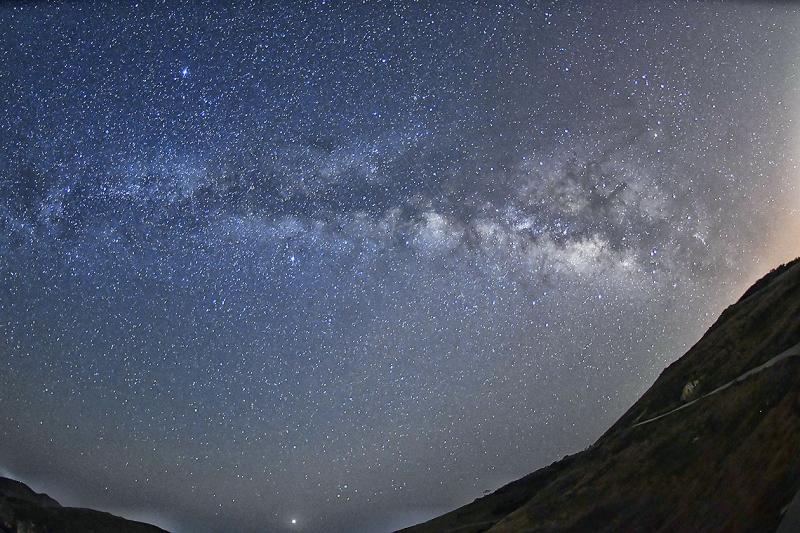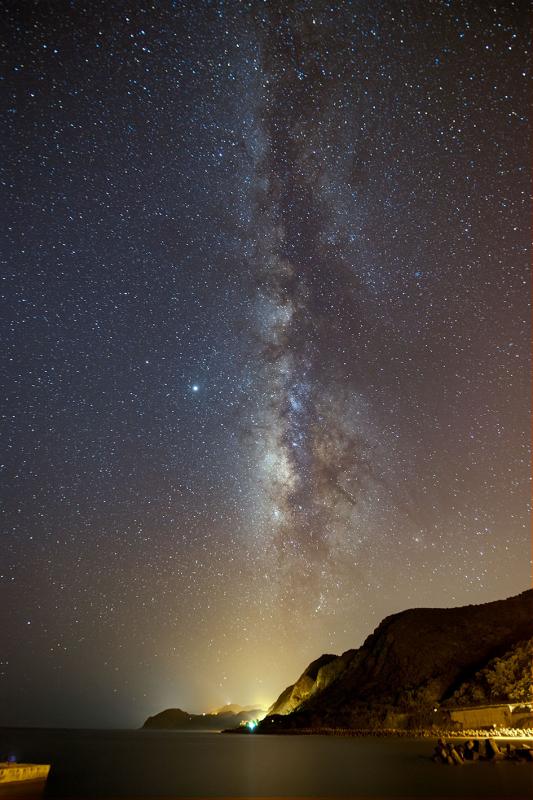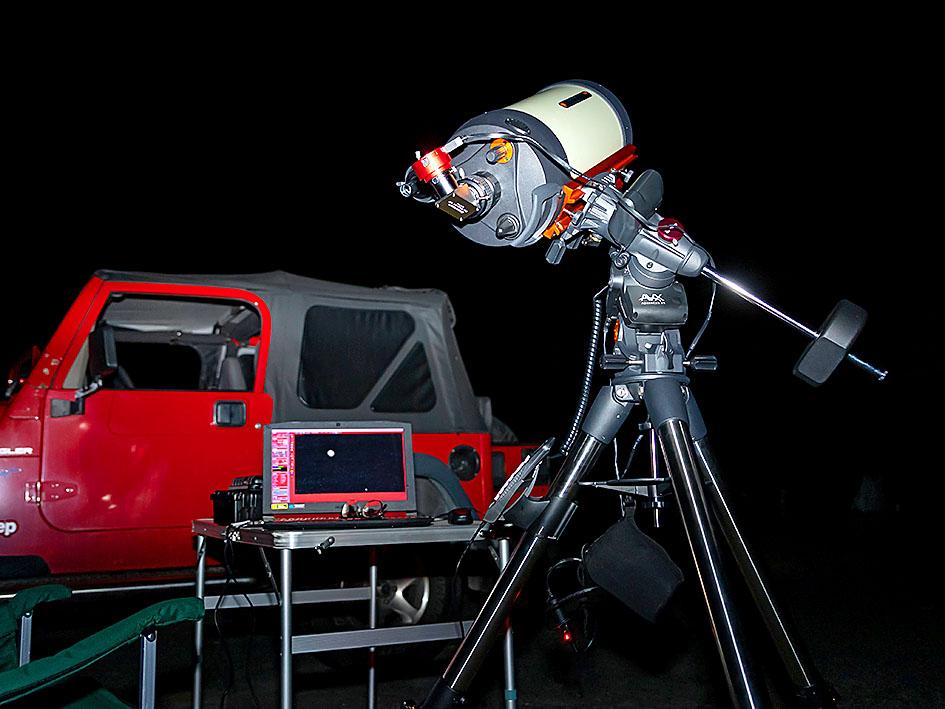The universe beyond the Earth’s atmosphere has fascinated Joseph Garrity for as long as he can remember.
When he was in preschool, he pleaded with his mother to stay up late for Star Trek. During his middle-school years, he went to the theater 13 times in one month to watch the first Star Wars movie. Nowadays, he can often be found on Taiwan’s east coast late at night, viewing and photographing the night sky.
Garrity, an American who’s lived in Hualien for the past 22 years, says that he’s fortunate to have some of Taiwan’s best stargazing spots almost on his doorstep.

Photo courtesy of Jim Hung
“The light pollution falls off dramatically just north of Yanliao Fishing Harbor (鹽寮漁港). It’s about as close to the city as you can get while being a low-light area according to the Bortle scale,” he says.
The nine-level Bortle scale is a way for amateur astronomers to evaluate and compare the observability of celestial objects and the interference caused by light pollution at different locations. A Class 1 site offers exceptional dark-sky conditions, whereas many inner city areas fall into Class 9, in which only the Moon, the planets, bright satellites and a few of the brightest star clusters can be discerned.
Garrity says Yanliao, 20km south of central Hualien, is probably Class 3 — a typical rural sky in which a lot is visible, yet with light pollution being evident at the horizon. If he drives out of Hualien in the oppositive direction, he adds, he can find good sky-viewing conditions a short distance north of Cisingtan Scenic Area (七星潭海岸風景區).

Photo courtesy of Joseph Garrity
“During the summer at Yanliao, usually around mid-August, the Milky Way is erect in the night sky around 10pm to 11pm. On clear weekend nights, there are often many visitors,” says Garrity, who first got into astronomy after his mother gave him a telescope one Christmas.
“I later bought a modestly priced telescope. Since moving to Taiwan, I’ve purchased an advanced rig. I’m using a Schmidt-Cassegrain with an equatorial mount, along with astrophotography gear,” he says, explaining that the mount enables a telescope to locate and track celestial objects, compensating for the Earth’s rotation by using an onboard motor and a computer.
Garrity goes stargazing as often as Hualien’s rainy climate permits. Because he works late afternoons and evenings, he can stay out until the wee hours if conditions are especially good. Astrophotography involves taking “long sequences of images, usually dozens if not hundreds, with long exposure times per frame, so a night out quickly becomes an all-nighter,” he says.

Photo courtesy of Joseph Garrity
KITTING UP
For Garrity, this isn’t a cheap pastime. He’s spent around US$5,000 on equipment, but he advises newbies to start with less specialized, more affordable gear. “You can use binoculars and take pictures with a DSLR camera and tripod. If you find your interest evolving, then investing in more expensive gear will be worth it to you,” he says.

Photo courtesy of Taiwan Dark-Sky Association
The weight of Garrity’s setup — something like 45kg — rules out hauling it to the summit of Jade Mountain (玉山) or another high mountain. Because positioning the rig on stable ground is important, he prefers places like parking lots.
Despite his passion for celestial objects, he’s yet to appreciate the nightscape in Hehuan Mountain Dark Sky Park (HMDSP, 合歡山暗空公園). The park was established in August 2019 with the support of Nantou County Government in the hope it’ll attract stargazing tourists.
“I’d like to make a trip to HMDSP, but lodging is difficult to come by and it has to be booked well in advance. If the weather doesn’t cooperate, cancellation fees could be a problem,” Garrity says.
He’d be willing to camp, but then the issue would be electrical outlets for recharging the numerous pieces of gear he uses.
The 1,345-hectare HMDSP is one of just four dark-sky parks in Asia recognized by the International Dark-Sky Association (IDA). Two are in Japan, while South Korea has one.
RECOMMENDED SKYGAZING LOCATIONS
HMDSP is among six stargazing locations recommended by Axiou Lin (林正修), chairman of the Taiwan Dark-Sky Association (台灣暗空協會, TDA), which is affiliated to the IDA.
The others are: Tataka Saddle (塔塔加鞍部) in Yushan National Park; Daqiu Island (大坵島) in the Matsu Islands; Qimei (七美) in Penghu County; Xuhai Grassland (旭海草原) in Pingtung County; and Yangmingshan (陽明山) in Taipei and New Taipei City.
For the past three years, the TDA has been helping Daqiu to obtain IDA certification, “and we hope to have good news by the end of this year,” Lin says.
He lauds Lianjiang County Government for tackling light pollution throughout the Matsu Islands, and urges the Nantou County Government to do the same for the entire area it administers, and not just within HMDSP.
Studying the night sky through binoculars, or even with the naked eye, can be just as exciting as using a professional-level telescope, Lin says. He suggests first-timers begin by downloading a star-tour app and using www.lightpollutionmap.info to find a promising night-sky viewing spot in their region.
Encouraging stargazing is a core goal of the TDA. “Our motto is ‘From the dark sky, confront the pollution of light,’” says Lin, who warns that light pollution around the world is increasing twice as fast as human population growth.
He adds that, because Taiwan’s population density is extremely high, if this issue isn’t dealt with, irresponsible outdoor lighting “will soon block our view of the universe.”
This matters, Lin says, because humans are curious by nature, and an extraplanetary perspective can help us grasp the fragility of the Earth.
Since ancient times, the night sky has been a source of wonder and inspiration. People have been studying and describing the constellations for millennia, but there’s still a huge amount to be learned.
Earlier this month, images from the James Webb Space Telescope were published, revealing spectacular but hitherto elusive cosmic features. “In the coming decades, astronomy will be the greatest adventure in human knowledge,” Lin says.
Whether you hope to learn or merely to ingest beauty, go out on a clear night, find a good dark spot in an unpopulated corner of the countryside, turn off your vehicle’s lights and look up. You could be pleasantly surprised. You just might be astonished.
Steven Crook has been writing about travel, culture and business in Taiwan since 1996. He is the author of Taiwan: The Bradt Travel Guide and co-author of A Culinary History of Taipei: Beyond Pork and Ponlai.

The Taipei Times last week reported that the rising share of seniors in the population is reshaping the nation’s housing markets. According to data from the Ministry of the Interior, about 850,000 residences were occupied by elderly people in the first quarter, including 655,000 that housed only one resident. H&B Realty chief researcher Jessica Hsu (徐佳馨), quoted in the article, said that there is rising demand for elderly-friendly housing, including units with elevators, barrier-free layouts and proximity to healthcare services. Hsu and others cited in the article highlighted the changing family residential dynamics, as children no longer live with parents,

The classic warmth of a good old-fashioned izakaya beckons you in, all cozy nooks and dark wood finishes, as tables order a third round and waiters sling tapas-sized bites and assorted — sometimes unidentifiable — skewered meats. But there’s a romantic hush about this Ximending (西門町) hotspot, with cocktails savored, plating elegant and never rushed and daters and diners lit by candlelight and chandelier. Each chair is mismatched and the assorted tables appear to be the fanciest picks from a nearby flea market. A naked sewing mannequin stands in a dimly lit corner, adorned with antique mirrors and draped foliage

The election of Cheng Li-wun (鄭麗文) as chair of the Chinese Nationalist Party (KMT) marked a triumphant return of pride in the “Chinese” in the party name. Cheng wants Taiwanese to be proud to call themselves Chinese again. The unambiguous winner was a return to the KMT ideology that formed in the early 2000s under then chairman Lien Chan (連戰) and president Ma Ying-jeou (馬英九) put into practice as far as he could, until ultimately thwarted by hundreds of thousands of protestors thronging the streets in what became known as the Sunflower movement in 2014. Cheng is an unambiguous Chinese ethnonationalist,

I was 10 when I read an article in the local paper about the Air Guitar World Championships, which take place every year in my home town of Oulu, Finland. My parents had helped out at the very first contest back in 1996 — my mum gave out fliers, my dad sorted the music. Since then, national championships have been held all across the world, with the winners assembling in Oulu every summer. At the time, I asked my parents if I could compete. At first they were hesitant; the event was in a bar, and there would be a lot